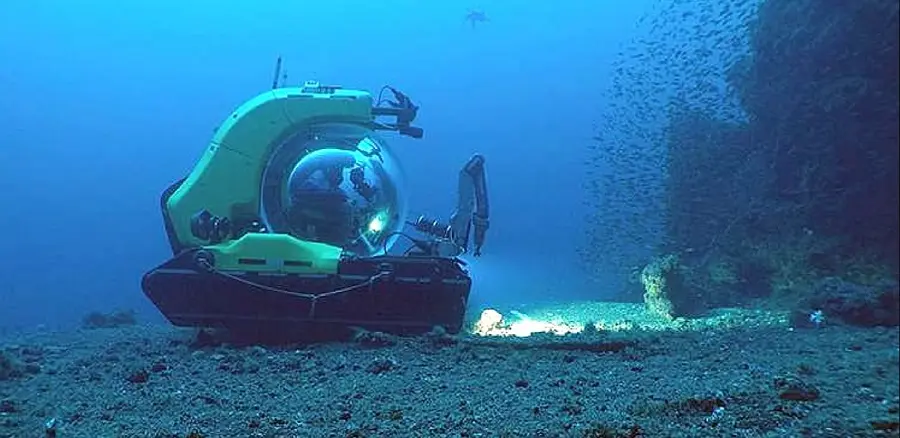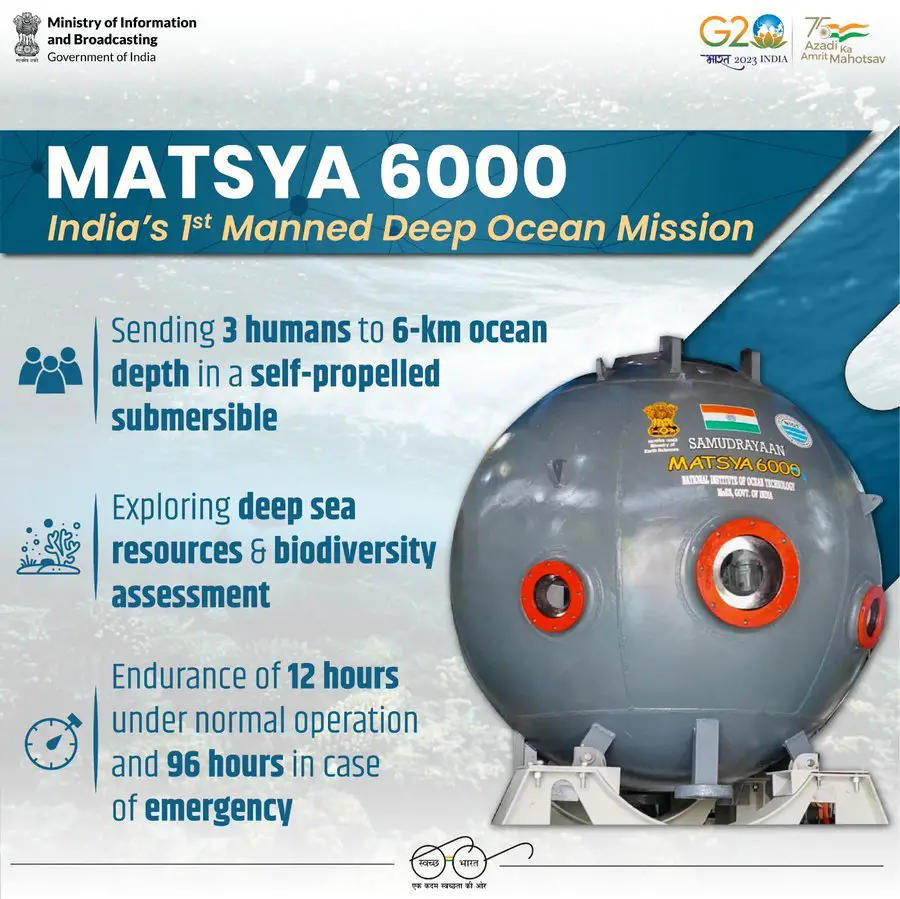
Why in News?
- India is about to become one of the select few countries with a dedicated deep-sea mission, a major achievement in the nation’s scientific and technological development.
- India will be the sixth nation in the world to undertake a mission of this kind, according to the Union Minister of Science and Technology and Minister of State for Earth Sciences.
- This historic accomplishment demonstrates India’s dedication to marine resource development that is sustainable, scientific innovation, and ocean exploration.
The Origins of India’s Submarine Expedition
- Over a crucial meeting to discuss the Ministry of Earth Sciences 100 Days Action Plan on a recent Saturday in New Delhi.
- The goal of India’s Deep-Sea Mission is to discover the secrets of the ocean depths, and the meeting focused on the mission’s future direction and progress India’s progress in this area, highlighting the country’s inclusion in a small group of nations that can conduct deep-sea exploration.
- India’s Deep-Sea Mission is a multi-pronged project intended to develop ocean sciences, explore marine flora and fauna, and conserve marine biodiversity in addition to mineral exploration.
India’s Deep-Diving Submersible, Matsya 6000

- At the heart of India’s Deep-Sea Mission is the Matsya 6000, a revolutionary submersible capable of descending to depths of 6,000 meters.
- Developed by the National Institute of Ocean Technology (NIOT), this technological marvel marks a significant milestone for India.
- The Matsya 6000 is expected to play a key role in advancing scientific research, exploring the depths of the ocean, and potentially uncovering new marine life and resources.
- The strides in technology are truly remarkable.
Technological Innovations
- Titanium Hull:
- To survive the intense conditions deep in the ocean, Matsya 6000 has a tough titanium shell created with help from the Indian Space Research Organisation (ISRO).
- This strong shell keeps the submersible safe and sound, letting it work well in the tough deep-sea conditions
- Self-Floatation Technology:
- As a result, the submersible can stay afloat on its own for approximately 3 days in case of emergencies.
- This feature not only safeguards the crew but also ensures that the submersible can resurface even in challenging conditions.
Testing and Trials
- The Matsya 6000 models have undergone extensive work and are now in the final stage of harbor trials.
- The first phase is anticipated to be completed by September 2024.
- Further trials are scheduled to be finished by 2026, paving the way for the submersible to become operational.
- These trials will evaluate the submersible’s overall functions, safety features, and performance, which is crucial given the challenging conditions of the deep-sea environment.
Impact of the Deep-sea Mission
Economic development determines the availability of resources for exploration
- Rare Earth Metals:
- In the light of the above background, the mission fulfils one of its major goals, that of exploration and exploitation of resources such as rare earth metals and polymetallic nodules present on the Indian seabed.
- The above resources mentionned are essential in several industries such as electronics, renewable energy as well as the defense sector. When the aforementioned underwater reserves are mined, it would lessen the dependence of India on imports and make it self-reliant in sourcing the materials.
- Marine Resources:
- Apart from identified lucrative resources such as rare earth metals, the mission will also focus on other marine resources capable of generating wealth such as minerals and forms of energy.
- It might result in the discovery of the new resources that would act as the catalyst and fulfill the requirement of an emerging economy like India for the enhancement of industrial and technological sectors.
Science, Technology, and the Earth
- Flora and Fauna Exploration:
- The mission will also involve studies of the different marine plants and animals which also comprehends the deep sea ecosystem.
- Search for fresh species and distribution of animals in the deep sea areas and increases awareness of the presence of the marine biosphere and its persistence and preservation.
- Ocean Science Development:
- Through the improvement of ocean research in the ION, the mission will improve understanding of the current, structure, and composition of the world’s oceans.
- These findings can be useful in making policies for the particular country and better management of the environment and also contributes to sustainable development.
India’s vision for Blue Economy and how the country can adapt
- Further identified the mission in the context of creating a more resilient blue economy that would mitigate the vulnerability of people whose livelihood depends on the availability of this resource.
- The blue economy means maximizing the utilization of resources available in oceans for wealth creation and people’s improvement while at the same time keeping the environment free from harm. India’s Deep-Sea Mission dovetails with this vision, and is related to the purpose of utilizing the ocean for resource benefits while maintaining the environmental balance of the ocean.
Empowering Coastal Communities
- Sustainable Fisheries:
- The mission’s evidence could help sustainable use of fish resources through Formulation of good fisheries policies that will enable sustainable fishing and feeds the coastal people because fish will also be available in plenty.
- Marine Biotechnology:
- Some possible benefits of going out to sea include the possibilities of finding new kinds of macro-molecules and micro-organisms that can be of use in technological and industrial fields.
- It could open the door for new economic possibilities for companies and businesses that are more linked to coastal or marine industries.
Joint and Future Endeavours
- India’s Deep-Sea Mission is a good example of the teamwork that is necessarily for any ocean mission.
- Of the list of strategies, the mission involves use of national counterparts including NIOT and ISRO and internationations.
- This cooperation also expands the mission’s areas of aim and reach by permitting India an active participation and receipt of knowledge in the development of oceanology all over the world.
Indigenous Technology Development
- The problems highlighted by Dr. Jitendra Singh include the need for self-reliance in technology to decrease dependence on other countries’ technology.
- In this way, India can increase the level of indigenization of research and development in ocean exploration and other related industries.
- This focus on indigenous development is also in concert with the overall national vision on providing support for “Made in India” projects and building up the nation’s technological capacity.
Global Contributions and Leadership
- With the initiation of specialized deep-sea missions, India marks itself as one of the newly entrant powerhouse members and becomes established in the international oceanographic community.
- The discoveries that will be polled through the Deep-Sea Mission shall be useful to not only India but also to the world in gaining more knowledge about the oceans.
- The study indicates that India is actively engaging in international collaborative endeavors and contributing to the international ocean research agenda, which is a positive sign of the country’s dedication to multiplex problems and global learned opinion.
Conclusion
- Deep Sea Mission of India is a giant leap towards ocean exploration and scientific capability of India.
- With the Matsya 6000 submersible and strategies for the deep sea exploration, India is ready with avenues for future contribution through ocean science and technology and thus, improving the economic front and the cause of environmental conservation.
- The mission’s success will; increase human knowledge of the deeper regions of the ocean, discover needed ore, metals, minerals, and other materials; help develop a sustainable ‘blue economy’.
- As India gets ready for this momentous journey the country aims towards the new horizon of discovery and invention that is to write a new chapter in the annals of oceanographic history and create a new record of scientific exploration and technological accomplishment.
FAQs
Q1: What is India’s DSM?
Ans: India’s Deep-Sea Mission isa new-age programme which has been started by India to map the deep sea. It is intended to explore the sea and conduct research on the water and understand the sea, its resources and the science and technology related to marine environment. It symbolizes India’s pledge to assume the role of a world premier in Hydrography.
Q2. Who declared the Deep-Sea Mission and what is the importance of it?
Ans: More details of this mission were declared by Dr Jitendra Singh, Union Minister of State for Science and Technology and Earth Science. This mission is important because, this makes India the sixth country to launch such a mission which is a great achievement in the Indian society, science, and technology taking into consideration the marine explorations.
I don’t think the title of your article matches the content lol. Just kidding, mainly because I had some doubts after reading the article.